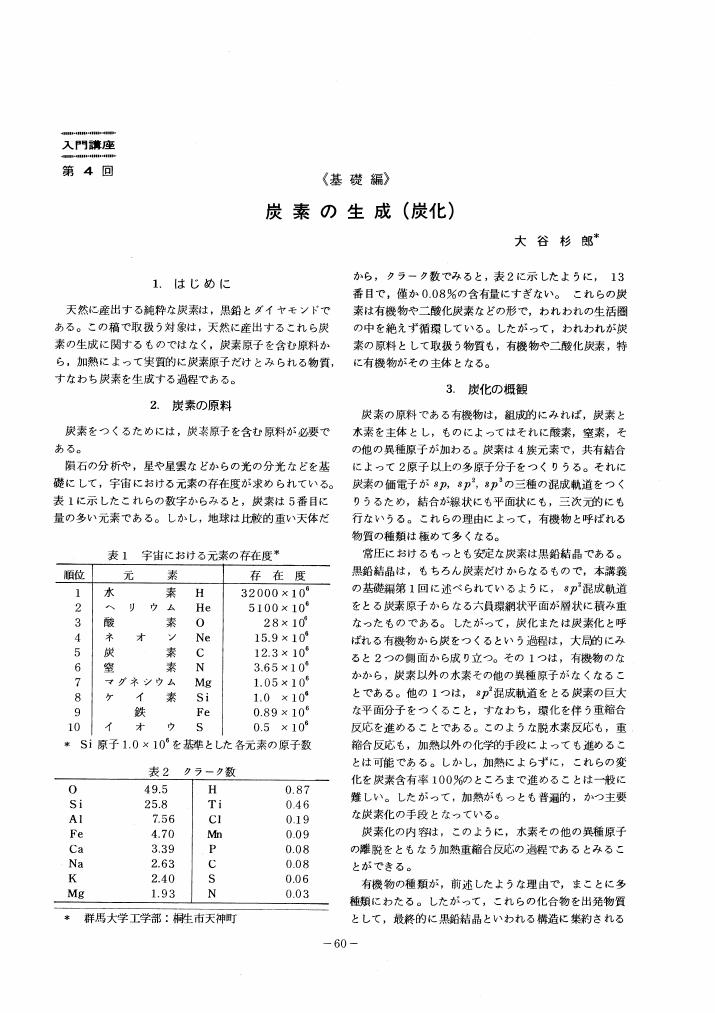2 0 0 0 OA 炭素繊維の表面改質によるエポキシ樹脂複合材料の色調と動的粘弾性の変化
- 著者
- 吉川 高雄 小島 昭 大谷 杉郎 安田 榮一
- 出版者
- THE CARBON SOCIETY OF JAPAN
- 雑誌
- 炭素 (ISSN:03715345)
- 巻号頁・発行日
- vol.1996, no.173, pp.148-153, 1996-07-30 (Released:2011-07-05)
- 参考文献数
- 28
In the paper, we prepared the carbon fibers/epoxy resin composites using modified carbon fibers by a new surface modification method named photo-oxygenation. Effects of the surface modification of carbon fibers on the properties of the composites and matrix resin have been studied through the estimation of color and dynamic viscoelastic properties of the composites. The obtained results are as follows.(1) Color and the dynamic viscoelastic properties of the composites change with carbon fibers' surface modified or not. So it is seen that the surface modification of reinforcing fibers changes not only the interphase but also the structure of matrix resin and its curing behavior.(2) The color properties and crosslinking density of the matrix resin are linearly related, so the color properties will be able to be applied for the quality control as curing estimation.
1 0 0 0 OA 一成分ベンゼン-置換体の熱分解
- 著者
- 大谷 杉郎 小林 弘
- 出版者
- THE CARBON SOCIETY OF JAPAN
- 雑誌
- 炭素 (ISSN:03715345)
- 巻号頁・発行日
- vol.1967, no.51, pp.2-7, 1967-11-15 (Released:2010-06-28)
- 参考文献数
- 5
- 被引用文献数
- 1
In order to get some fundamental informations related to a mechanism of carbonization, pyrolysis of the mono- substituted benzene derivatives (benzene, toluene, chlorobenzene, nitrobenzene, aniline, anisole, benzyl alcohol, acetophenone, benzaldehyde and phenol) was studied by use of a flowing gas reactor at below 600°C.According to the initial temperature of decomposition, the thermal reactivities are arranged in the order as follow: ph-CHO>ph-OCH3>ph-NO2>ph-CH2OH>ph-COCH3 >benzene>ph-Cl>ph-NH2>ph-CH3>ph-OH. And the mechanism of the decomposition of the each derivative is suggested on the basis of the quantitative analysis of the products.
- 著者
- 太田 道也 大谷 杉郎 飯塚 晋司 沢田 剛 小島 昭
- 出版者
- 公益社団法人 日本化学会
- 雑誌
- 日本化学会誌 (ISSN:03694577)
- 巻号頁・発行日
- vol.1988, no.6, pp.975-980, 1988
さきに報告した, ピレン, フェチントレン混合物を原料とし, ベンゼンジメタノールのジメチル置換体 (DM) を橋かけ剤とする COPNA 樹脂を用いて, 最高 2500℃ まで加熱し, 炭素化処理した。そのさいの樹脂の構造変化を調べ, DM 系樹脂の炭素化機構を PXG 系の場合と比較検討した。合成した DM 系樹脂は 120℃ で20時間硬化したのち, 200℃ で1時間後硬化し, これを炭素化の出発原料とした。加熱処理は, 窒素気流中で 1400℃ までは 5℃/minの昇温速度で, 1400 から 2500℃ までは 20℃/min で行なった。<BR>DM 系は PXG 系と異なり, 450℃ で完全に液化した。そして, この液相状態がみられる温度域では, 樹脂中に光学的に異方性を示す液晶部分, いわゆるメソフェーズが観察された。2500℃ までの各温度で加熱処理した樹脂炭の文線回折測定の結果, DM 系は典型的な易黒鉛化性挙動 (2500℃ 処理において, d<SUB>(002)</SUB>=0.336nm, Lc=33nm) を示すことがわかった。
1 0 0 0 OA 炭素の生成 (炭化)
1 0 0 0 縮合多環多核芳香族 (COPNA) 樹脂の炭素化挙動
- 著者
- 大谷 杉郎 子洪 〓 太田 悦郎
- 出版者
- 炭素材料学会
- 雑誌
- 炭素 (ISSN:03715345)
- 巻号頁・発行日
- vol.1986, no.127, pp.162-170, 1986
- 被引用文献数
- 6
Thermosetting resins named COPNA resin were prepared by heating polycondenced armotic compounds (Aro) with 1, 4-benzenedimethanol (PXG) and p-toluensulfonic acid as a catalyst. Aro used were pyrene/phenanthrene (7/3 in molar ratio) mixture (PP), napth-alene and coal-tar pitch. The COPNA resins were heat-treated between 200 and 2500°C to examine their carbonization behaviors. Major/results obtained are:<BR>(1) The COPNA resins derived from PP or naphtalene with an amount of PXG above 1.0 in PXG/Aro molar ratio decomposed first thermally around 450°C. Thus, the methylene bridges in the COPNA resins were broken down around 450°C. The pitch-based COPNA resin exhibited the weight loss over a wider temperature range.<BR>(2) Carbon yields from the COPNA resins increased with both increasing, molecular weight of raw Aro and the cross-linkage density. They were 38 and 60 wt% for the naphthalene (PXG/Aro=1.25 in molar ratio) based-and the pitch (PXG/Aro=2.0 in molar ratio) based-COPNA resins respectively. The PP-based one showed an intermediate value between them.<BR>(3) The COPNA resins after heating to 2500°C gave X-ray parameters corresponding to those for the non-graphitizable carbon. hitizability of those resins improved with the increasing molecular weight of Aro and/or the decreasing molecular ratio of PXG/Aro.
